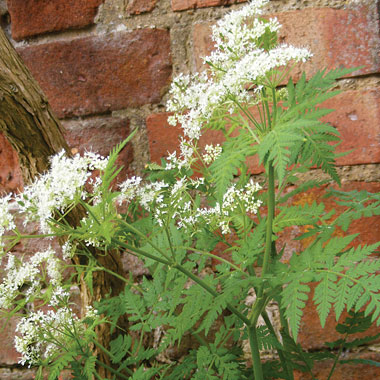


Sweet Cecily (Garden Myrrh)
Myrrhis odorata

Sweet cecily is a sweet member of the celery family.
Its divided feathery foliage is especially attractive from early spring as it unfolds.
As the leaflets mature they gain white markings and are fragrant with the scent of anise and overtones of other aromatics.
The frothy white flowerheads appear in late spring and early summer and are much appreciated by the first butterflies.
All parts of the plant are aromatic and useful, from the foliage and flowers to the large seeds
and also the long tap roots below the soil.
Sweet cecily originates from the mountains of southern Europe
and is now found in moist areas all over Europe and Asia, both in wild and garden situations.
Historically it has been grown in Britain for many centuries
and is most certainly described by that celebrated herbalist Culpepper in the 1600s.
It has long been used as a digestive and tonic herb, as a mild disinfectant and as to aid coughs and anaemia.
However the best known and most popular use for sweet cecily is in cooking.
The leaves are used as a natural sweetener, their most well known use is as an addition
to tart fruit such as rhubarb, blackcurrants and gooseberries.
Cooking fruit with chopped sweet cecily means that you only need to use half the normal quantity of sugar,
reducing your calorie / sugar intake in a herbal way!
When the first rhubarb is ready to pick so are the leaves of sweet cecily at their best.
Try planting some of the herb near your rhubarb root so that you can harvest both at the same time.
Chopped leaves can also be added to soups and stews, omelettes and are surprisingly good when cooked with cabbage.
The leaves do need to be used fresh, or at a pinch frozen, as the dried herb loses its aroma.
To improve fresh leaf production remove the flowering stems from one or two plants throughout the growing season.
Don't remove too many flower stems however as the seeds have their own uses.
The green unripe seeds have a sweet nutty quality and are good added to fruit desserts and chopped into ice cream.
As the seeds ripen they become dark brown and shiny, these are a flavouring in some liqueurs.
Sweet cecily self-seeds and multiplies in ideal situations,
if you need to remove surplus plants then remember that the long tap roots can be peeled
and sliced into salads or cooked like carrots.
Yorkshire is famed for the best rhubarb and so what more appropriate
than a sweet yorkshire pudding filled with rhubarb and sweetened with sweet cecily.
Rhubarb and Sweet Cecily Yorkshire Pudding
Serves 4 - 6
- 350 g young rhubarb (5 - 6 stalks)
- 90 g sultanas or raisins
- 25 g chopped young sweet cecily leaves
- 40 g butter
- 2 heaped tbs brown sugar
- 1 tbs corn oil - or another unflavoured oil
- 120 g plain flour
- 180 ml milk
- 4 eggs
Method:
- Preheat the oven to 400F, Gas Mark 6 or 200C (180C fan).
- Cut the rhubarb into 2 - 3 cm lengths and put in a bowl, cover with boiling water.
- Leave for 1 minute and then drain, this softens the rhubarb.
- Add the sultanas and sweet cecily to the rhubarb and set aside.
- Heat the butter, oil and sugar in a small pan over a low heat until the sugar melts then pour the mixture into the bottom of a small roasting tin. Heat the tin in the oven until the oil just starts to bubble.
- Make a batter by beating together the flour, milk and eggs and pour this quickly into the roasting tin on top of the butter and sugar mix.
- Sprinkle the rhubarb mix down the centre of the pan leaving a 3 cm gap around the edge to puff up whilst it cooks.
- Bake for about 20 minutes, watching during the last 5 minutes in case the edge of the pudding becomes burnt.
- Serve traditionally with custard or with greek yoghurt.
Sweet Cecily Vodka Schnapps
- Take approximately 300 ml of sweet cecily leaves stripped from the stems (measured by packing the foliage tightly into a measuring jug) and put into a wide necked jar.
- Add 500 ml of vodka and leave for 3 days or longer according to taste, shaking gently daily.
- Strain off the aromatic green liqueur and serve chilled as an aperitif or after dinner drink.
- The green seeds can also be used to flavour the vodka, add a handful of the roughly chopped seeds to 500 ml of vodka and again infuse for 3 days or until you are satisfied with the depth of flavour.